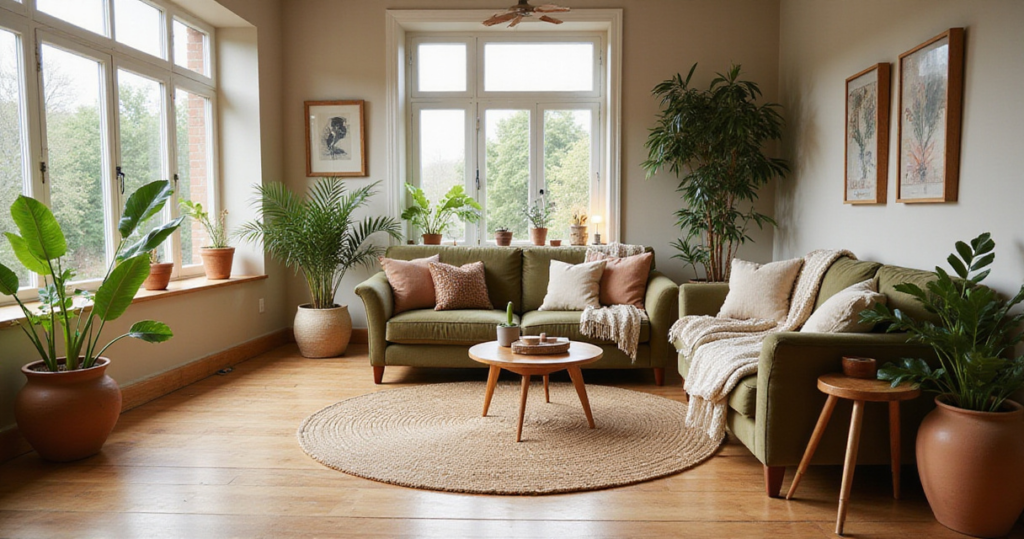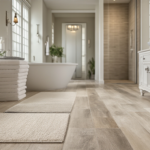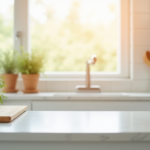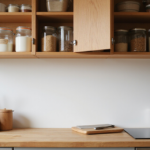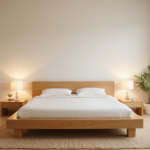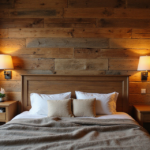Stepping into a truly bohemian living room feels like discovering a hidden sanctuary where every corner whispers stories of distant travels and cherished memories. This isn’t about following rigid design rules or achieving magazine-perfect symmetry – it’s about creating a space that breathes with your authentic spirit. The magic of bohemian living room decor lies in its ability to transform any ordinary room into an extraordinary haven that celebrates individuality, comfort, and the beautiful imperfections that make a house feel like home.
Picture yourself surrounded by layers of rich textures, where handwoven rugs cascade beneath vintage furniture pieces that have weathered decades with grace. Imagine walls adorned with macrame tapestries casting intricate shadows in the golden hour light, while an abundance of trailing plants brings life to every corner. This is the essence of bohemian design – a philosophy that embraces the collected, the loved, and the lived-in over the pristine and predictable.
Whether you’re starting with a blank canvas or looking to infuse your existing space with bohemian soul, these 24 carefully curated ideas will guide you toward creating a living room that truly reflects your free-spirited nature. Each suggestion honors the bohemian tradition of mixing vintage treasures with global finds, natural materials with artistic expressions, creating a space that feels both grounded and wonderfully eclectic.
1. Layer Vintage Textiles for Authentic Character
The foundation of any authentic bohemian living room decor begins with the artful layering of vintage textiles that carry stories from decades past. Unlike mass-produced fabrics, vintage textiles possess an irreplaceable patina – those subtle color variations, gentle wear patterns, and unique imperfections that speak to their journey through time. When you drape a 1960s suzani throw over a contemporary sofa or place a weathered Persian runner beneath a modern coffee table, you’re not just adding decoration; you’re weaving history into your daily life.
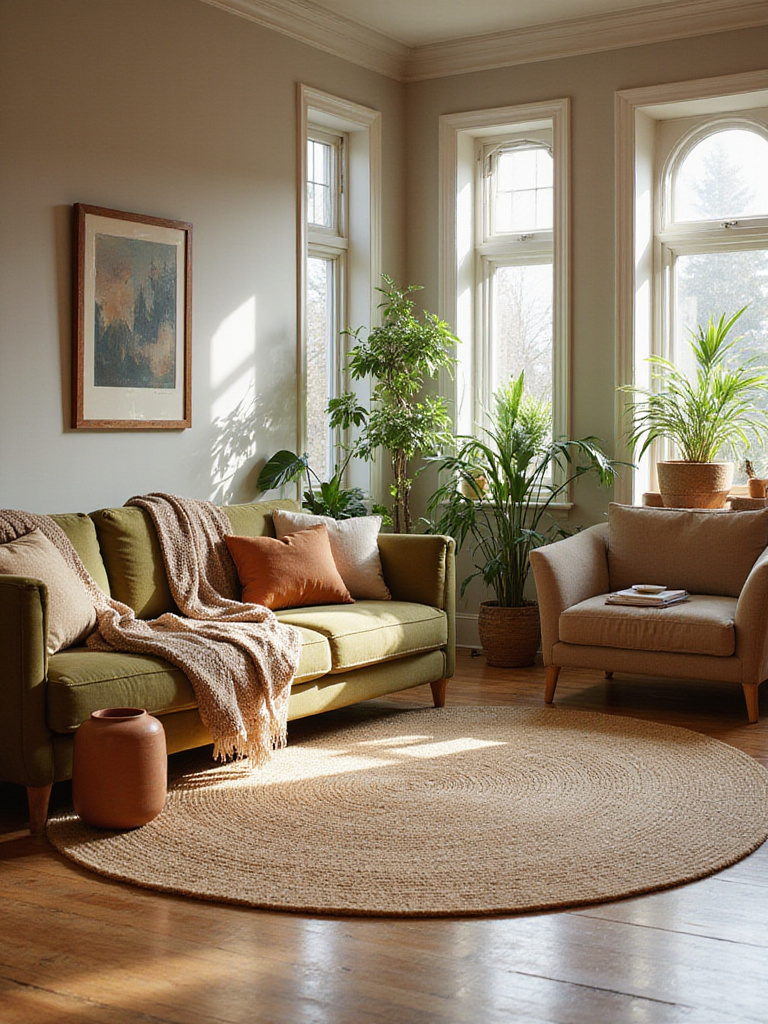
The beauty of vintage textiles lies in their ability to anchor a space with authenticity while providing incredible versatility. A single antique kilim can serve as wall art one season, then transition to floor covering the next. These pieces often feature natural dyes that have mellowed into sophisticated, complex hues impossible to replicate in modern manufacturing. The craftsmanship evident in hand-knotted fringes, intricate embroidery, and traditional weaving techniques adds a level of artisanal quality that elevates the entire room’s aesthetic.
Look closely and you’ll notice the subtle texture of aged cotton in a vintage Indian bedspread, how it catches afternoon light differently than its modern counterparts, creating depth and visual interest that transforms throughout the day.
2. Create Intimate Seating with Floor Cushions
Floor cushions represent the heart of bohemian philosophy – the rejection of formal, rigid living in favor of relaxed, communal comfort. This approach to seating transforms your living room into a flexible, intimate space where conversations flow more naturally and relaxation becomes effortless. Large, plush floor cushions covered in rich fabrics like velvet, embroidered cotton, or vintage tapestry materials create an inviting landscape that encourages people to settle in and truly unwind.
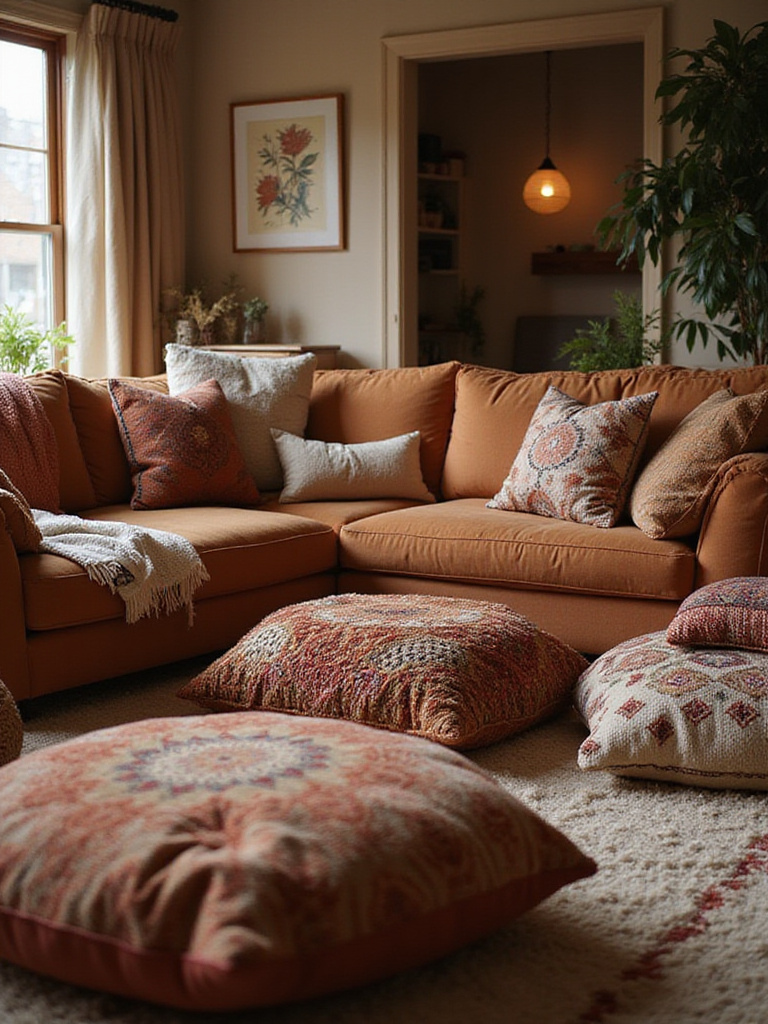
The practical benefits extend beyond comfort. Floor seating naturally creates a more democratic social environment where everyone sits at the same level, fostering deeper connections and more intimate conversations. This arrangement also offers incredible flexibility – cushions can be rearranged for different activities, stacked for storage, or moved to accommodate varying group sizes. The visual impact is equally compelling, as floor cushions add layers of texture and color while maintaining the low, grounded aesthetic essential to bohemian design.
- Mix textures and sizes: Combine large square cushions with smaller round ones, varying materials from smooth velvet to nubby wool
- Create zones: Arrange cushions around a low table or rug to define conversation areas
- Layer for depth: Place cushions on vintage rugs and add throws for additional comfort and visual richness
The challenge of awkward spaces becomes easier when you embrace the fluid nature of floor seating, allowing your room to adapt to life’s changing rhythms.
3. Showcase Global Artifacts and Curiosities
Your travels and cultural interests deserve to be celebrated, not hidden away in storage boxes. Displaying carefully chosen global artifacts transforms your bohemian living room decor into a personal museum that reflects your curiosity about the world. These pieces – whether a carved wooden mask from Bali, a collection of vintage brass vessels from Morocco, or handwoven baskets from Ghana – serve as conversation starters and windows into different cultures and traditions.
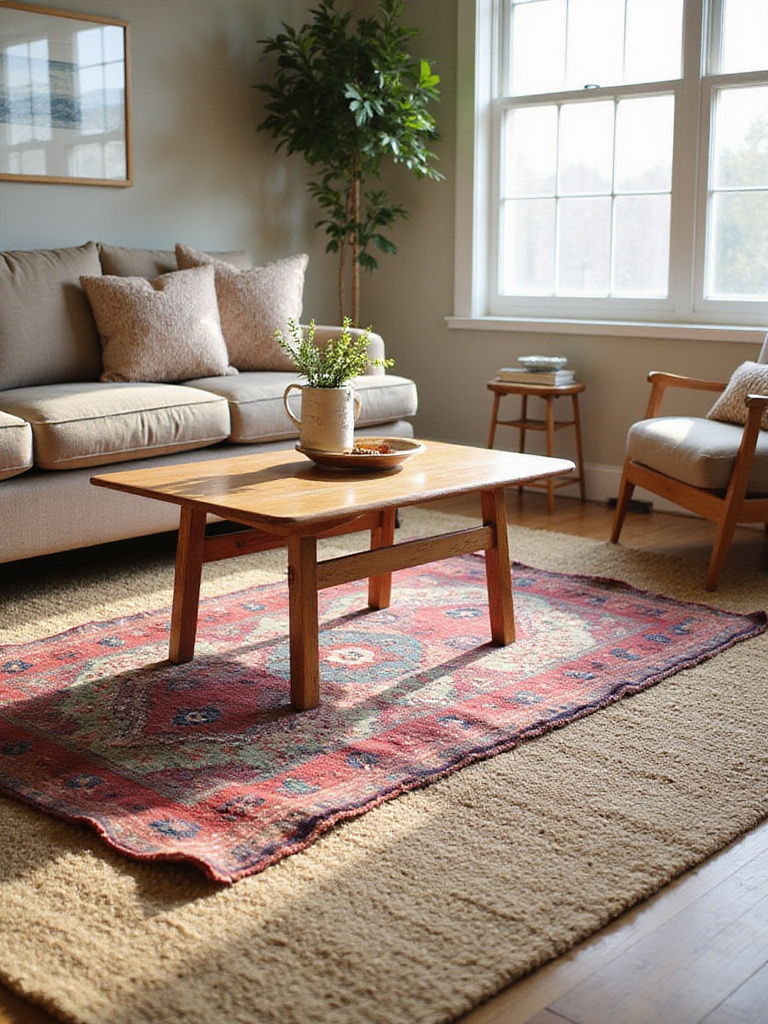
The key lies in thoughtful curation rather than overwhelming display. Each piece should earn its place through beauty, meaning, or craftsmanship. Arrange artifacts in small vignettes that tell stories – perhaps grouping ceramics from a memorable trip alongside photographs and a piece of local textile. This approach creates visual interest while maintaining the collected-over-time aesthetic that defines authentic bohemian style. The patina and wear on these pieces add irreplaceable character that new items simply cannot provide.
- Vary heights and textures: Create dynamic displays by mixing tall vessels with low bowls, smooth ceramics with rough wood
- Rotate seasonally: Keep displays fresh by occasionally swapping pieces from storage
- Honor origins: Research and appreciate the cultural significance of your pieces, displaying them with respect
What makes this design special is the way these artifacts bridge the gap between your living room and the wider world, creating a space that feels both intimately personal and globally connected.
4. Establish a Warm Earth-Tone Foundation
The color palette forms the emotional backbone of your space, and earth tones provide the perfect foundation for bohemian living room decor. These colors – think terracotta, warm ochre, deep forest green, and rich chocolate brown – create an immediate sense of grounding and comfort. Unlike cool, stark palettes that can feel clinical, earth tones wrap your space in warmth and create a cocoon-like atmosphere that invites relaxation and contemplation.
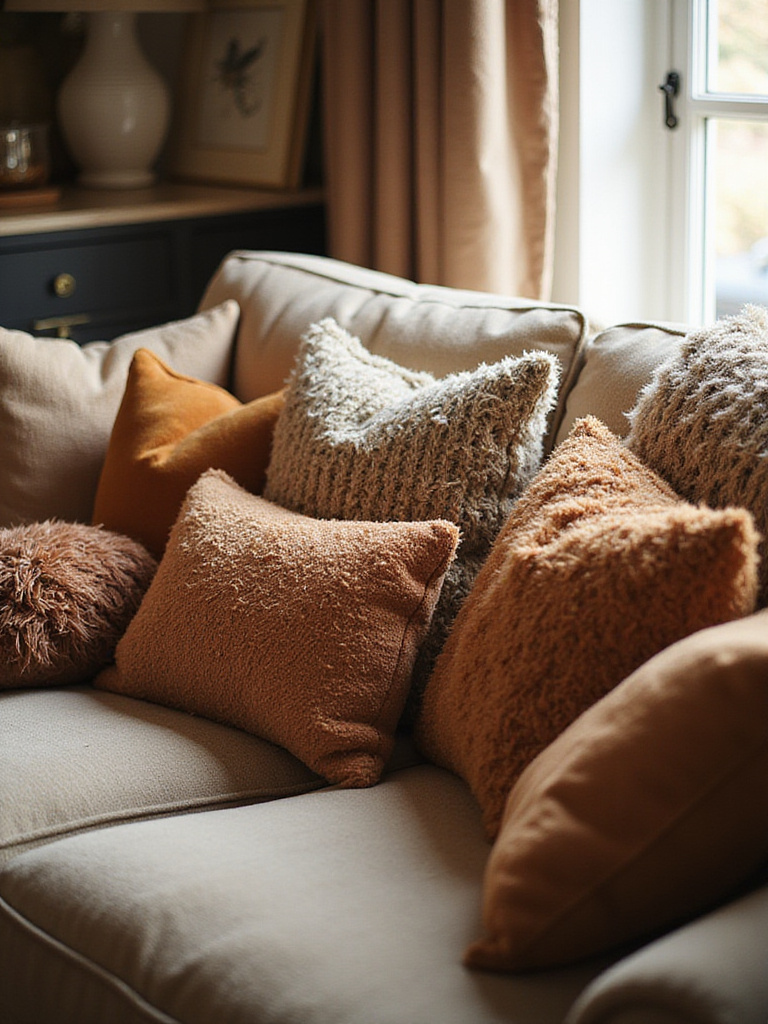
Building your palette around these natural hues provides incredible flexibility for layering patterns, textures, and accent colors. Earth tones serve as a sophisticated neutral backdrop that allows vintage textiles, global artifacts, and abundant plants to shine without competing for attention. The psychological impact is profound – these colors are inherently calming and help create the sanctuary-like quality that makes bohemian spaces so appealing.
Start with larger elements like wall color or a substantial sofa in a warm neutral, then layer in deeper earth tones through textiles and accessories. This approach ensures your space feels cohesive while maintaining the eclectic spirit essential to the style. The beauty lies in how these colors age gracefully, developing character over time rather than looking dated.
Beyond the obvious placement, consider using earth tones in unexpected ways – perhaps painting just one accent wall in deep terracotta or choosing window treatments in warm ochre linen.
5. Incorporate Living Walls of Greenery
Plants aren’t merely decorative elements in bohemian living room decor – they’re essential partners in creating a space that breathes with life and vitality. The abundance of greenery characteristic of bohemian style goes far beyond a single fiddle leaf fig in the corner. Think cascading pothos trailing from high shelves, clusters of succulents on coffee tables, and statement plants like monstera or bird of paradise anchoring corners with their dramatic foliage.

The layering of plants at different heights creates a lush, jungle-like atmosphere that softens hard edges and adds organic movement to your space. Hanging plants from macrame holders, placing trailing varieties on tall shelves, and grouping floor plants of varying heights creates depth and visual interest while improving air quality and psychological well-being. The key is embracing abundance – in bohemian design, more is often more when it comes to greenery.
- Create plant clusters: Group plants in odd numbers with varying heights and leaf textures
- Mix containers: Use woven baskets, vintage ceramics, and macrame hangers for eclectic appeal
- Consider light needs: Match plants to your room’s natural light conditions for healthy, thriving displays
The tactile experience changes the entire room’s energy when you surround yourself with this much living beauty, creating a space that feels more like a conservatory than a conventional living room.
6. Design with Intentional Asymmetry
Forget the rigid rules of traditional interior design – bohemian living room decor thrives on intentional asymmetry that creates visual interest and reflects the organic, collected-over-time aesthetic. This doesn’t mean chaos or carelessness; rather, it’s about creating balance through variety rather than matching pairs. An oversized floor cushion balanced by a small side table, or a large piece of wall art offset by a cluster of smaller objects, creates dynamic tension that keeps the eye engaged.
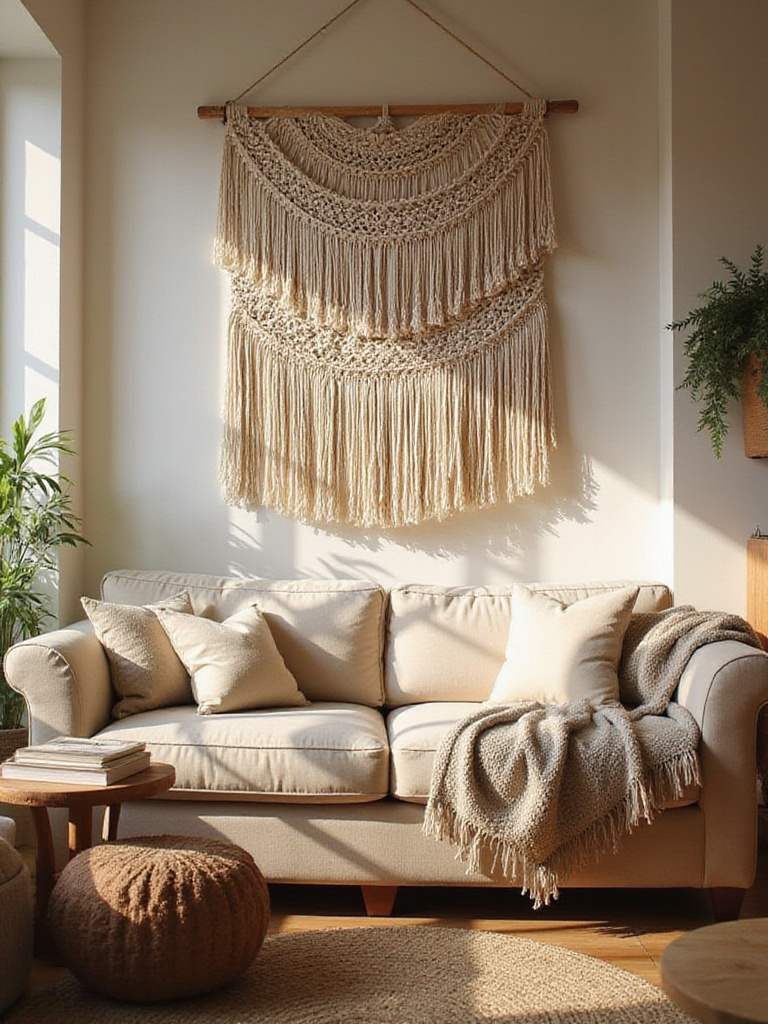
This approach extends to furniture arrangement, where perfect symmetry gives way to more natural, conversational groupings. Perhaps your sofa angles slightly toward a window for better light, with a vintage trunk serving as both coffee table and storage positioned off-center. Lighting follows the same principle – instead of matching table lamps, you might combine a floor lamp with a hanging pendant and some candles for layered, asymmetrical illumination.
The freedom from symmetry allows each piece to shine individually while contributing to the overall composition. This creates a space that feels lived-in and personal rather than staged, reflecting the bohemian philosophy of embracing life’s beautiful imperfections.
The styling mistake most people make is trying to balance everything perfectly, when the magic actually happens in those moments of intentional imbalance.
7. Layer Vintage and Contemporary Lighting
Lighting in bohemian spaces should feel like a warm embrace rather than stark illumination. The key lies in layering multiple light sources at varying heights and intensities, creating pools of warm light that invite intimate conversation and relaxation. Vintage pendant lights with character – perhaps a Moroccan lantern or a 1970s macrame shade – can anchor your lighting scheme while table lamps with warm bulbs provide task lighting for reading and close work.
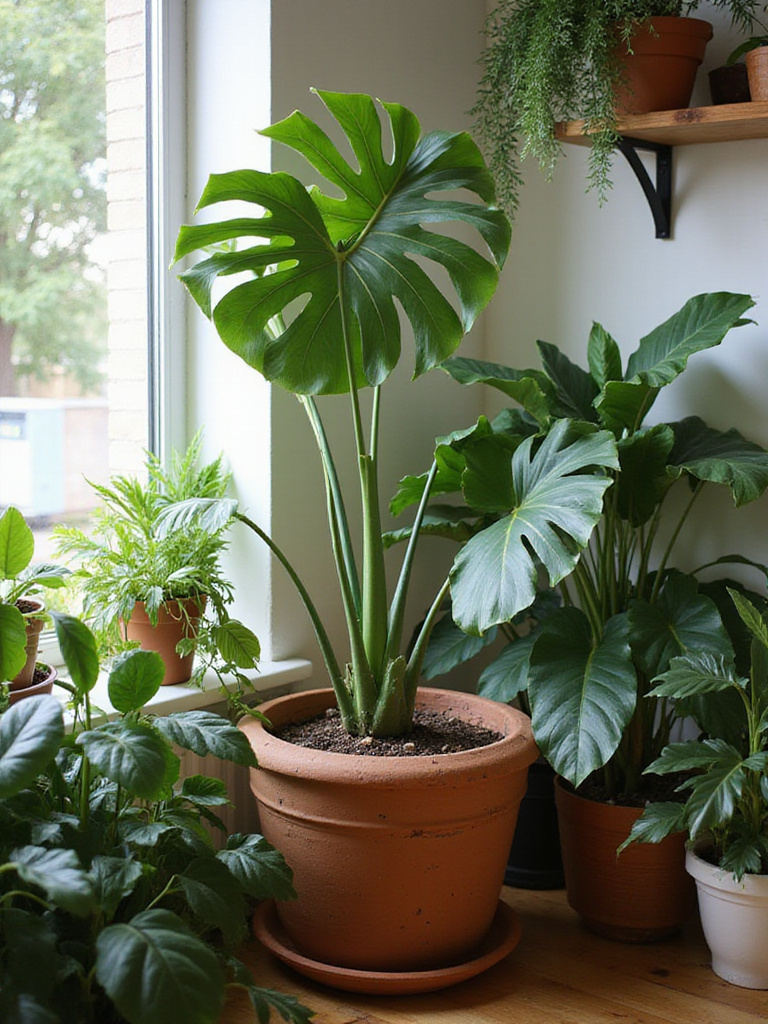
The magic happens when you combine these functional lights with ambient elements like string lights draped casually around doorways or candles clustered on surfaces. This layered approach eliminates harsh shadows while creating the golden, honeyed light quality that makes bohemian living room decor so inviting. Each light source should contribute to the overall atmosphere while maintaining its own character and purpose.
Consider the interplay between different materials – the warm glow of Edison bulbs through woven shades, the flicker of candlelight against metallic surfaces, or the soft wash of light from paper lanterns. This variety in both light quality and fixture materials adds to the eclectic, collected aesthetic while ensuring your space remains functional for various activities throughout the day.
As morning light filters through, the texture creates different moods when combined with your carefully chosen artificial lighting, making your space feel dynamic and alive.
8. Embrace Maximalist Wall Treatments
Bohemian walls tell stories through layers of art, textiles, and objects that create rich, textured surfaces full of visual interest. This maximalist approach moves beyond single statement pieces to create gallery-like walls that reflect your interests, travels, and aesthetic evolution. Mix framed vintage prints with woven tapestries, mirrors with interesting frames, and three-dimensional objects like small shelves holding curiosities or trailing plants.

The key to successful maximalist wall treatment lies in finding common threads – perhaps a consistent color palette, similar frame materials, or a shared theme – that unify diverse elements. This creates cohesion within complexity, allowing individual pieces to shine while contributing to a larger composition. The walls become an ever-evolving canvas that can grow and change as you discover new treasures or your interests shift.
- Vary scales and shapes: Mix large statement pieces with smaller supporting elements
- Include dimensional objects: Add floating shelves, small sconces, or hanging plants for depth
- Leave some breathing room: Even maximalist walls need strategic negative space to avoid overwhelming the eye
The composition comes together when you view the wall as a single artistic statement rather than a collection of individual pieces, creating a backdrop that’s both visually rich and deeply personal.
9. Create Cozy Reading Nooks
Every bohemian living room deserves a dedicated space for quiet contemplation and literary escape. These intimate corners transform unused areas into personal sanctuaries that invite you to slow down and savor peaceful moments. A reading nook might be as simple as a comfortable chair positioned near a window with good natural light, surrounded by a small side table for tea and books, and softened with textiles that make the space feel separate from the room’s main activity.
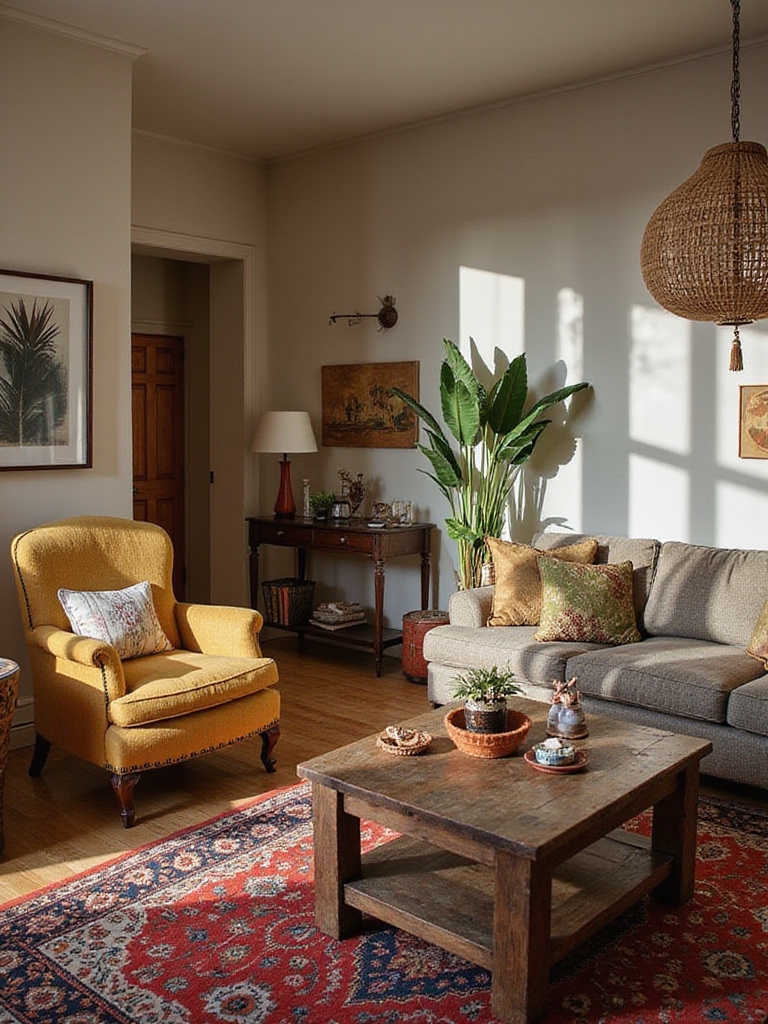
The beauty of a well-designed reading nook lies in its ability to create psychological separation within an open space. Strategic placement of a floor lamp, a small rug to define the area, and perhaps a hanging plant or wall-mounted shelf for books helps establish this corner as a distinct zone. The seating should prioritize comfort over style – think overstuffed armchairs, window seats piled with cushions, or even a daybed that invites afternoon naps with a good book.
Layer in personal touches that reflect your reading habits and preferences. A basket for storing current reads, a soft throw for chilly evenings, and perhaps a small plant or two create an environment that feels nurturing and inspiring. The goal is creating a space so inviting that you’ll naturally gravitate toward it during quiet moments.
Picture the warmth of evening conversations around this intimate space, where the boundary between living room and personal retreat beautifully blurs.
10. Display Books as Living Decor
Books in bohemian living room decor serve dual purposes – they’re both functional libraries and decorative elements that reveal your intellectual curiosities and aesthetic preferences. Rather than hiding books behind closed doors, embrace them as part of your room’s visual landscape. Stack vintage hardcovers to create impromptu side tables, arrange colorful spines by hue for artistic impact, or display special editions and beautiful covers as you would any other art object.
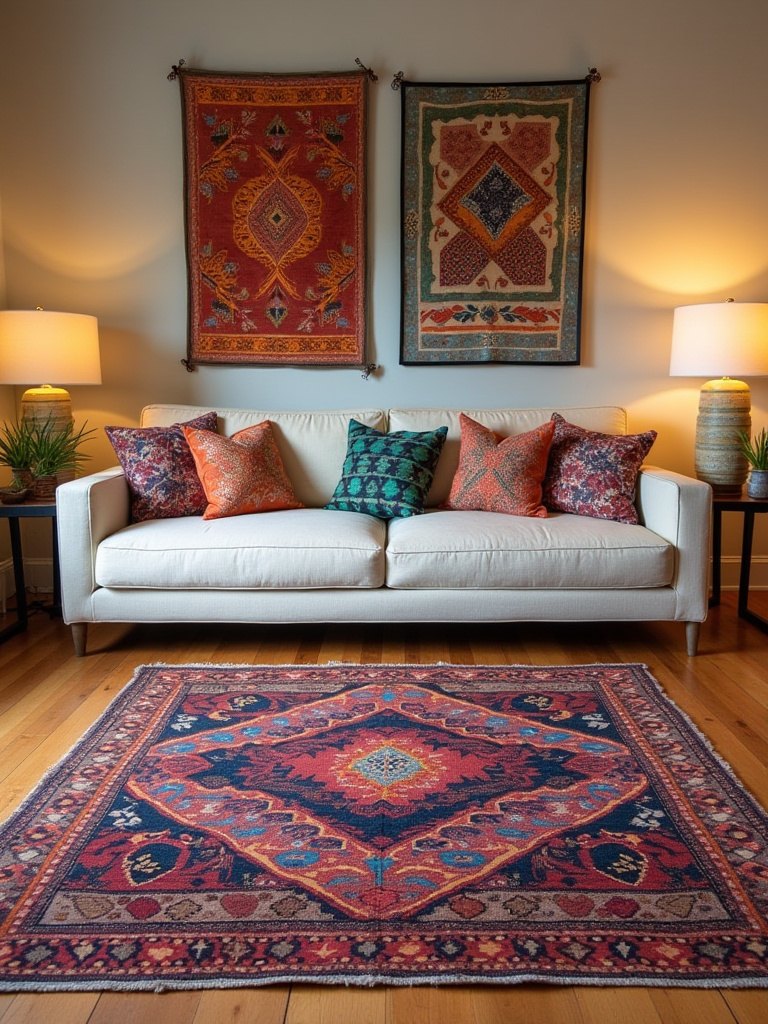
The organic nature of book collections – with their varied sizes, colors, and conditions – adds to the collected, lived-in feeling essential to bohemian style. Mix horizontal and vertical arrangements, leave some books slightly askew, and intersperse volumes with small objects like plants, candles, or curiosities. This creates vignettes that feel natural and personal rather than overly curated.
Consider the stories your book display tells about your interests and journey. Travel guides from past adventures, art books that inspire your decorating choices, and well-worn novels that have shaped your thinking all contribute to the narrative your space tells about who you are. The gentle wear on favorite volumes adds character that new books simply cannot provide.
- Mix genres and sizes: Combine coffee table books with paperback novels and vintage finds
- Create small vignettes: Pair books with objects that relate to their content or your memories
- Use books functionally: Stack sturdy volumes to elevate plants or create impromptu surfaces
The unexpected pairing that always works is combining books with natural elements like small plants or stones, creating displays that feel both intellectual and organic.
11. Integrate Handwoven Baskets for Storage
Handwoven baskets solve the eternal bohemian challenge of maintaining a collected, lived-in aesthetic while keeping everyday clutter at bay. These functional art pieces, crafted from natural materials like seagrass, rattan, or palm fronds, provide essential storage while adding texture and global flair to your space. Their organic shapes and natural color variations contribute to the earthy, handcrafted quality that defines authentic bohemian living room decor.
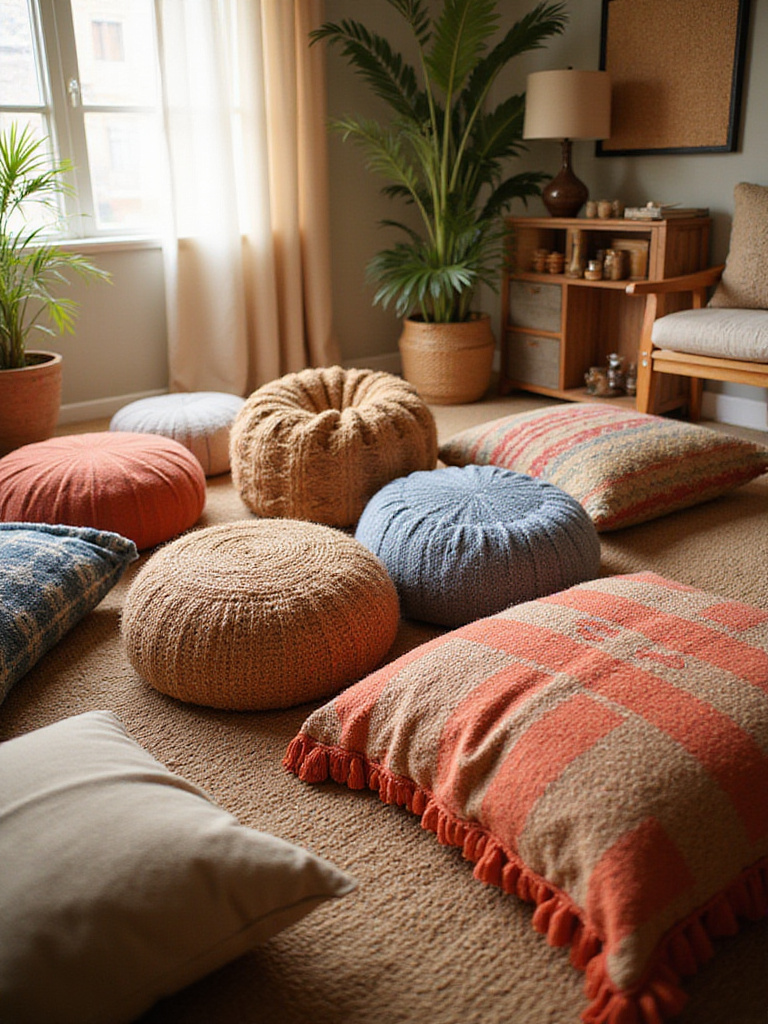
The versatility of baskets makes them indispensable in bohemian spaces. Large floor baskets can corral throws and pillows, medium-sized versions work perfectly for magazines and books, while smaller baskets organize remotes, candles, and other daily necessities. The natural aging process of these materials adds character over time, developing a beautiful patina that enhances rather than detracts from their appearance.
Choose baskets from different regions and weaving traditions to create an eclectic collection that reflects global craftsmanship. African sweetgrass baskets might sit alongside Mexican palm leaf versions and Indonesian rattan designs, each bringing its own cultural story and aesthetic contribution to your space. The slight variations in color, texture, and technique add visual interest while maintaining functional utility.
Running your hand across this material reveals the individual artisan’s technique, connecting you to the hands that created these functional works of art.
12. Celebrate Imperfect Vintage Furniture
The most compelling pieces in bohemian living room decor often carry the gentle scars of their previous lives – a coffee table with water rings that tell stories of countless gatherings, a vintage armchair with fabric softened by decades of use, or a wooden dresser with paint worn smooth by countless hands. These imperfections aren’t flaws to hide; they’re badges of honor that speak to a piece’s journey through time and its capacity to be loved.
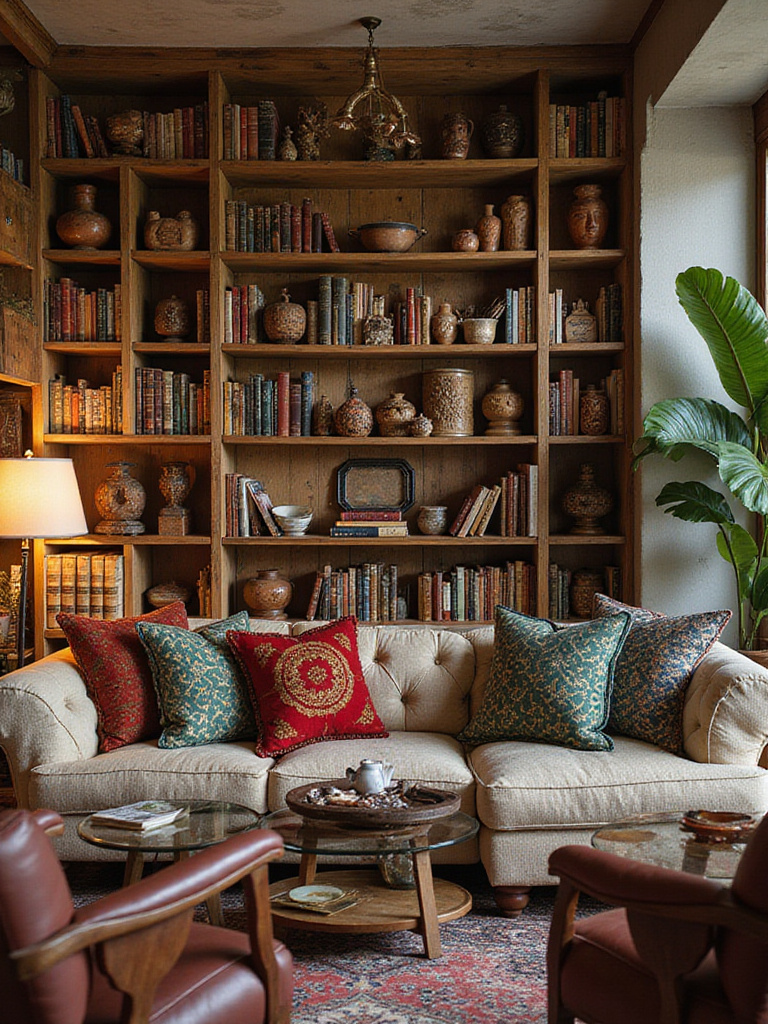
Seeking out furniture with character requires shifting your perspective from pristine to patinated. That brass lamp with a gentle green patina has more soul than its shiny new counterpart. The wooden side table with slight scratches and dings carries stories that mass-produced furniture never will. This approach aligns with bohemian philosophy’s emphasis on authenticity over perfection, creating spaces that feel genuinely lived-in rather than showroom-perfect.
The key lies in distinguishing between character-building wear and structural damage. A beautifully aged leather chair with a soft patina and gentle creases is a treasure; one with broken springs is simply broken. Learn to see potential in pieces that need minor restoration – perhaps new cushions or a gentle cleaning – while avoiding those requiring major structural work.
- Look for solid construction: Focus on well-built pieces with good bones, regardless of surface wear
- Embrace natural aging: Seek out patina, gentle wear patterns, and color variations that add character
- Consider restoration potential: Choose pieces that need minor refreshing rather than major reconstruction
The craftsmanship reveals itself in details like dovetail joints on vintage drawers or the way a wooden chair’s arms have been worn smooth by generations of use.
13. Layer Persian and Kilim Rugs
The foundation of any bohemian living room begins with the artful layering of rugs that create visual depth and define different zones within your space. Persian and kilim rugs bring centuries of weaving tradition into your home, each piece carrying unique patterns, colors, and stories that mass-produced rugs simply cannot match. The slight irregularities in hand-knotted pieces – variations in tension, subtle color changes, or small imperfections – add character and authenticity that machine-made alternatives lack.

Layering these rugs creates a rich tapestry underfoot that anchors your furniture while adding warmth and visual interest. A large, neutral-toned kilim might serve as your base layer, with a smaller, more intricately patterned Persian rug placed strategically under your seating area or coffee table. This technique allows you to introduce bold patterns and colors without overwhelming the space, while the varying textures add tactile richness that invites bare feet and casual lounging.
The investment in quality vintage or antique rugs pays dividends in longevity and character. These pieces often improve with age, developing a beautiful patina and softness that new rugs require years to achieve. The natural dyes used in traditional weaving create complex colors that shift subtly in different light conditions, making your floor covering a dynamic element that changes throughout the day.
The visual weight balances perfectly when you pair a bold, geometric kilim with a more organic, flowing Persian design, creating harmony through contrast.
14. Install Floating Shelves for Curated Displays
Floating shelves transform blank wall space into opportunities for storytelling, allowing you to create carefully curated vignettes that reflect your personality and interests. In bohemian living room decor, these displays should feel organic and collected rather than rigidly styled. Mix books with small plants, vintage finds with contemporary ceramics, and personal photographs with interesting objects that catch the light or add textural variety.

The key to successful shelf styling lies in embracing the rule of threes and varying heights, textures, and visual weights. A stack of vintage books might anchor one end of a shelf, balanced by a trailing plant and a small sculptural object. This creates visual rhythm while maintaining the slightly imperfect, lived-in quality essential to bohemian aesthetics. Leave some breathing room between objects – negative space is as important as the items themselves in creating appealing compositions.
Consider how your displays will look from different angles and distances. Items should be interesting up close but also contribute to the room’s overall visual flow. Rotate objects seasonally or when you acquire new treasures, keeping your displays fresh and reflective of your evolving interests and aesthetic preferences.
- Group in odd numbers: Arrange objects in clusters of three or five for naturally pleasing compositions
- Vary textures and heights: Mix smooth ceramics with rough wood, tall objects with low ones
- Include living elements: Add small plants or fresh flowers to bring life to static displays
The finishing touch that elevates the entire look is ensuring each shelf tells a small story while contributing to your room’s larger narrative.
15. Choose Furniture with Curved Lines
The gentle curves of rounded furniture pieces soften the angular architecture of most homes, creating the flowing, organic feeling essential to bohemian living room decor. Curved elements – whether a kidney-shaped coffee table, a round ottoman, or an arched floor mirror – introduce movement and visual interest while maintaining the relaxed, non-rigid aesthetic that defines bohemian style. These pieces feel more approachable and intimate than their angular counterparts, inviting touch and encouraging the casual interaction central to bohemian philosophy.
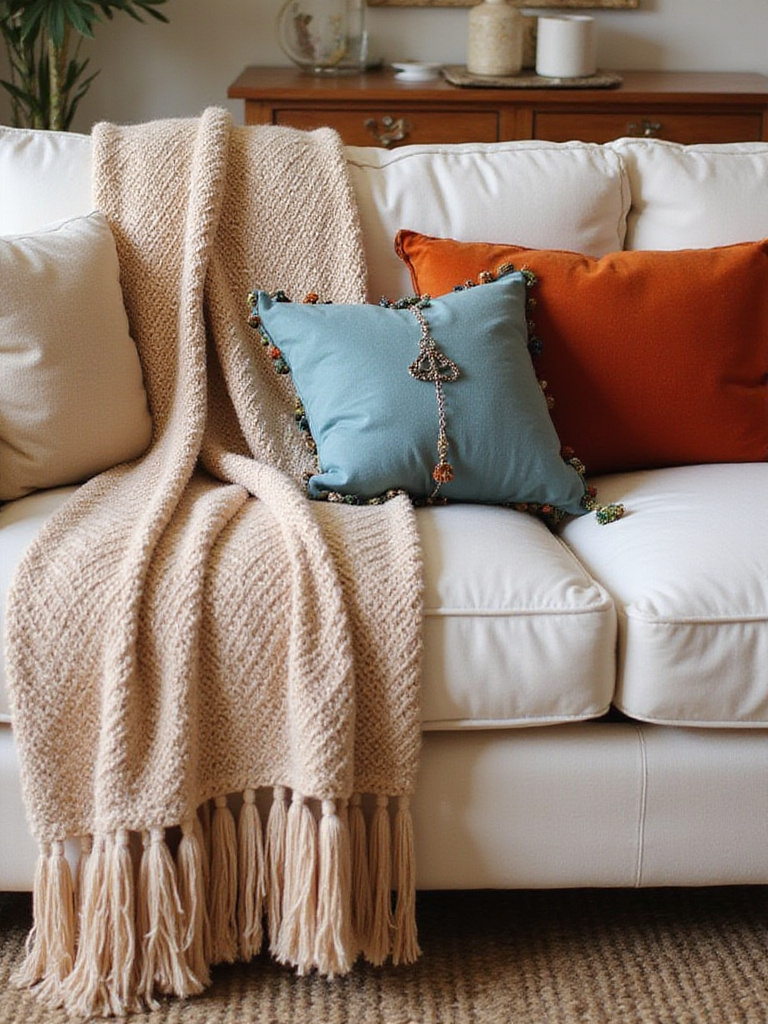
Curved furniture also improves traffic flow in smaller spaces, eliminating sharp corners that can make navigation awkward. A round coffee table encourages conversation by eliminating the hierarchy of head and foot positions, while curved seating naturally creates more intimate groupings. The psychological impact is significant – curves are inherently calming and feel more human-scaled than stark geometric forms.
Look for pieces that combine curves with interesting materials or textures. A round rattan coffee table brings both organic shape and natural texture, while a curved velvet sofa adds softness in both form and feel. The interplay between curved forms and the angular elements already present in your space creates visual tension that keeps the eye engaged without feeling chaotic.
The silhouette draws inspiration from natural forms – the curve of a river stone, the arch of a tree branch – connecting your interior space to the organic world beyond your walls.
16. Create Gallery Walls with Mixed Media
Gallery walls in bohemian spaces break free from the matchy-matchy constraints of traditional design, embracing an eclectic mix of artwork, photographs, textiles, and three-dimensional objects that create visual richness and personal narrative. This approach allows you to display your growing collection of meaningful pieces without waiting for the perfect matching set. Mix framed prints with unframed canvases, photography with textile art, and flat pieces with dimensional objects like small shelves or hanging plants.
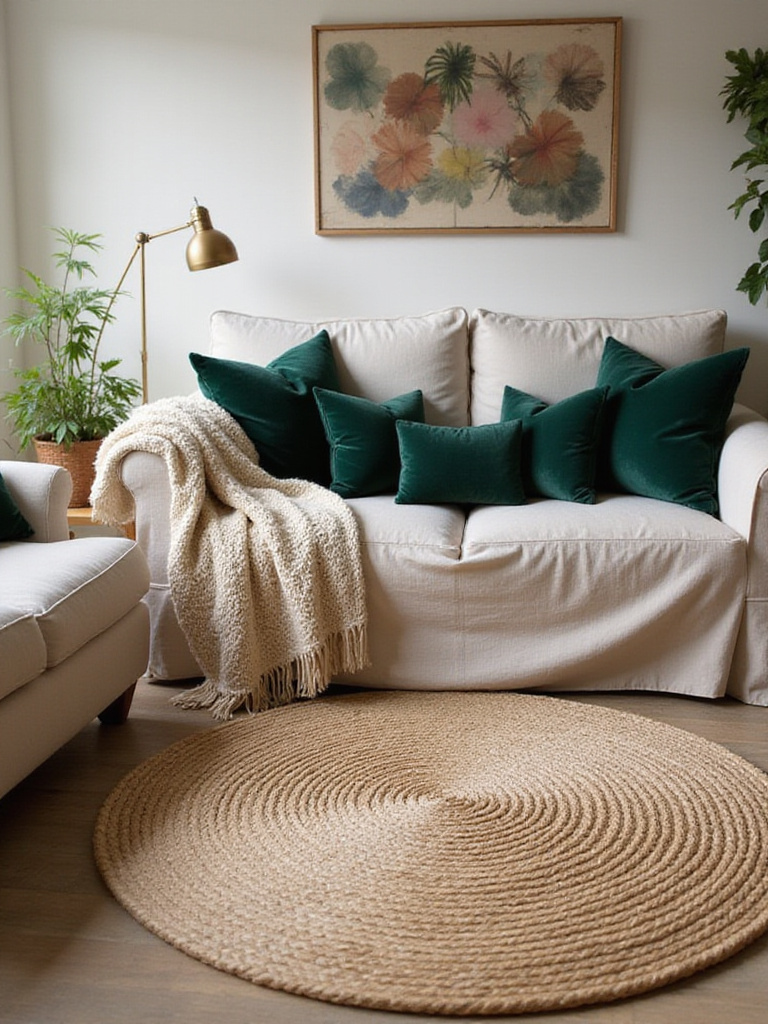
The organic, collected-over-time feeling comes from varying frame materials, sizes, and styles while maintaining some unifying elements – perhaps a consistent color palette or a shared theme. Start with your largest or most important piece as an anchor, then build around it with smaller supporting elements. Don’t be afraid to include unconventional items like vintage mirrors, small woven baskets, or even interesting architectural fragments that add texture and dimension.
The beauty of bohemian gallery walls lies in their evolution – they can grow and change as you discover new pieces or your interests shift. This flexibility keeps your space feeling fresh and personal while accommodating the natural ebb and flow of collecting and curating that defines the bohemian approach to living.
- Start with an anchor piece: Choose one larger or more significant item as your focal point
- Mix frame materials: Combine wood, metal, and even frameless pieces for eclectic appeal
- Include dimensional elements: Add small shelves, mirrors, or hanging plants for depth
The composition comes together when you step back and view the entire wall as a single artistic statement rather than a collection of individual pieces.
17. Incorporate Moroccan and Turkish Elements
The rich design traditions of Morocco and Turkey offer a treasure trove of elements that enhance bohemian living room decor with their intricate patterns, luxurious textures, and exotic appeal. Moroccan poufs provide flexible seating while adding authentic craftsmanship and rich colors to your space. Turkish kilims bring centuries-old weaving traditions to your floors, while brass lanterns and carved wooden screens add architectural interest and cultural depth.

These elements work beautifully because they embody the bohemian principles of handcraftsmanship, global influence, and rich ornamentation. A single Moroccan brass tray can transform a simple coffee table into an exotic focal point, while Turkish ceramics add color and pattern to shelving displays. The key lies in choosing pieces that feel authentic rather than costume-like – seek out items with genuine craftsmanship and cultural significance rather than mass-produced imitations.
The layering of these elements with your existing decor creates the global, well-traveled aesthetic central to bohemian style. A Turkish kilim might anchor your seating area while Moroccan lanterns provide ambient lighting and carved wooden elements add architectural interest. This combination creates depth and visual richness that reflects the bohemian celebration of diverse cultural traditions.
The artisans behind these designs began with techniques passed down through generations, creating pieces that carry cultural knowledge and artistic tradition into your contemporary living space.
18. Design with Natural Light in Mind
Natural light serves as the most important design element in bohemian living room decor, influencing how colors appear, how textures are revealed, and how the space feels throughout the day. Rather than fighting your room’s natural light conditions, embrace them and design accordingly. South-facing rooms with abundant light can handle deeper colors and richer textures, while north-facing spaces benefit from lighter palettes and reflective surfaces that maximize available illumination.
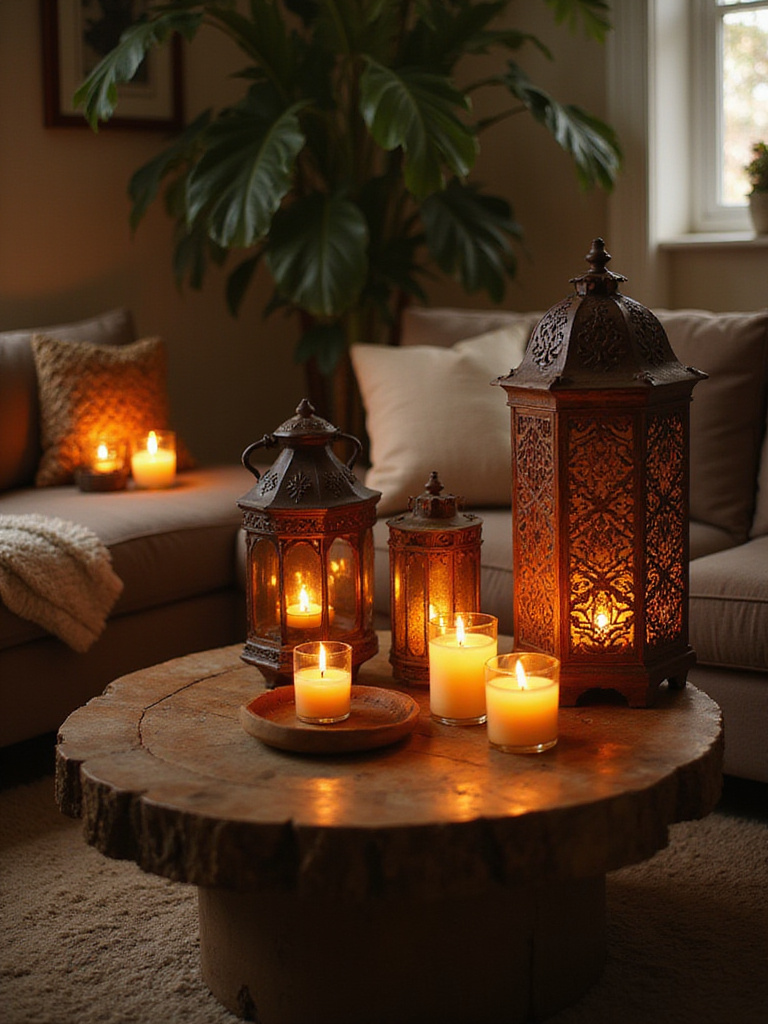
Consider how light moves through your space during different times of day and seasons. Morning light might highlight a reading corner, while afternoon sun could create dramatic shadows through hanging plants or macrame wall hangings. This awareness allows you to position key elements – artwork, plants, seating areas – where they’ll be most effective and beautiful throughout the day’s changing light conditions.
Window treatments in bohemian spaces should filter rather than block light, creating the soft, diffused illumination that makes these rooms so inviting. Sheer curtains, bamboo blinds, or even strategically placed plants can provide privacy while maintaining the connection to natural light that keeps bohemian spaces feeling fresh and alive.
- Position seating near windows: Take advantage of natural light for reading and conversation areas
- Use light-colored surfaces: Reflect available light with pale walls, mirrors, and metallic accents
- Filter harsh light: Soften direct sun with sheer curtains or climbing plants
As morning light filters through, the texture creates an ever-changing display of shadows and highlights that brings your carefully chosen objects and textiles to life.
19. Mix Metals for Eclectic Appeal
The bohemian approach to metals embraces the beauty of mixing rather than matching, creating visual interest through the interplay of different finishes, patinas, and textures. Brass candlesticks might sit alongside copper planters and silver-framed mirrors, each metal bringing its own character and warmth to the space. This eclectic mixing reflects the collected-over-time aesthetic essential to bohemian living room decor, suggesting pieces gathered from various sources and periods rather than purchased as a coordinated set.
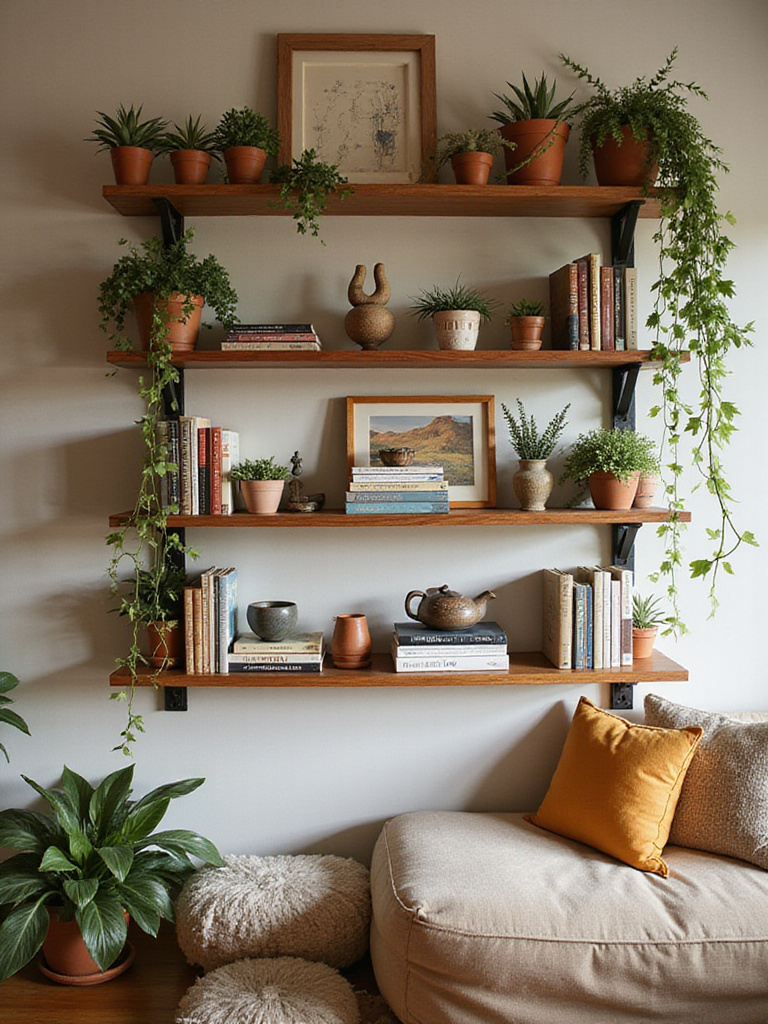
The key lies in balancing warm and cool tones while maintaining some common elements – perhaps similar levels of patina or comparable scales. Aged brass and copper share warm undertones that complement each other, while the addition of pewter or silver provides cool contrast that keeps the mixture from becoming monotonous. The natural aging process of metals adds character that new, shiny pieces lack, developing beautiful patinas that enhance rather than diminish their appeal.
Consider the functional aspects of different metals as well as their aesthetic contributions. Brass lanterns provide warm, flickering light, copper vessels work beautifully as planters, and iron elements add structural interest. This functional diversity supports the bohemian philosophy of beautiful utility, where decorative elements also serve practical purposes in daily life.
The interplay between the colors creates subtle harmonies and contrasts that change as light conditions shift throughout the day, making your metal elements dynamic rather than static decorative features.
20. Embrace Seasonal Flexibility
Bohemian living room decor should evolve with the seasons, reflecting the natural world’s changing rhythms while maintaining its core aesthetic principles. This flexibility allows your space to feel fresh and responsive to both weather changes and your own shifting moods and needs. Summer might bring lighter textiles, more plants, and brighter accents, while winter calls for deeper colors, additional layers, and cozier lighting.
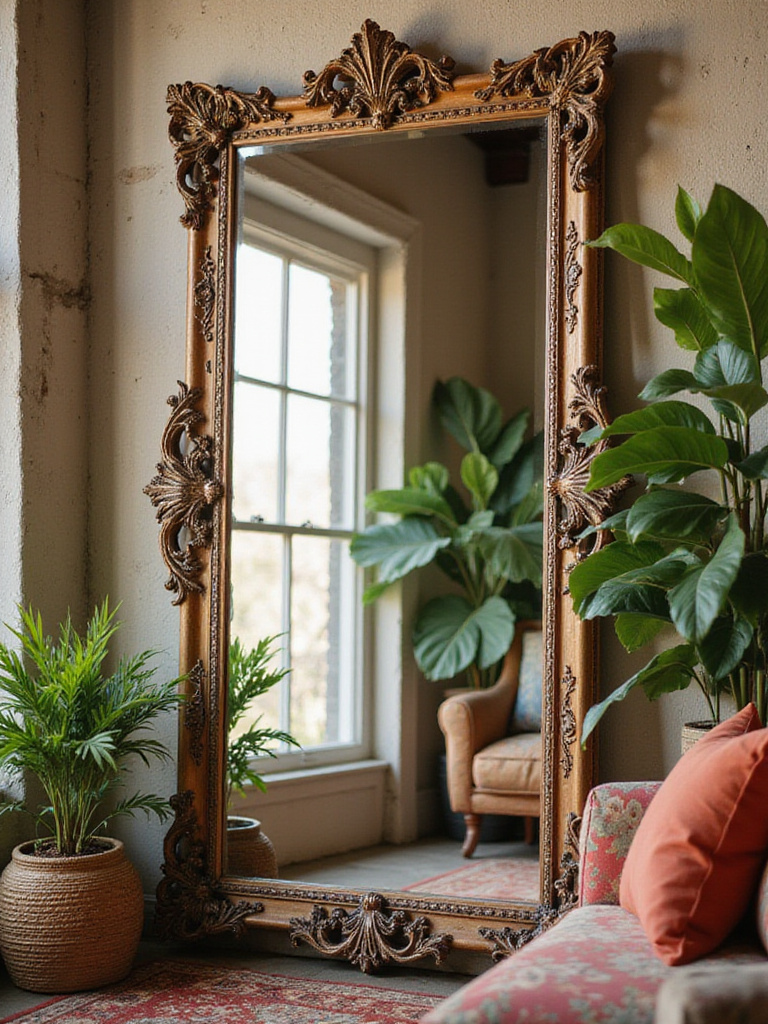
The key lies in having a flexible foundation that can accommodate seasonal changes without requiring complete redecoration. Neutral base colors, quality furniture pieces, and versatile lighting provide stability while allowing textiles, plants, and accessories to shift with the seasons. This approach aligns with bohemian values of sustainability and mindful consumption, encouraging you to refresh your space through thoughtful editing rather than wholesale replacement.
Seasonal changes might be as simple as swapping lightweight cotton throws for chunky wool ones, replacing summer’s bright flowers with autumn’s dried grasses, or adjusting lighting from bright and energizing to warm and cozy. These subtle shifts keep your space feeling current and responsive while maintaining its essential bohemian character.
- Rotate textiles seasonally: Store heavier pieces during warm months, lighter ones during cold
- Adjust plant displays: Move sun-loving plants closer to windows in winter, create shade in summer
- Modify lighting: Use brighter bulbs in winter’s short days, softer light during long summer evenings
The mood shifts dramatically when you add seasonal elements that reflect the natural world’s changing beauty, keeping your space connected to the larger rhythms of life.
21. Create Intimate Conversation Areas
Bohemian living rooms prioritize human connection over formal presentation, creating multiple intimate seating areas that encourage conversation and relaxation. Rather than focusing all seating on a television or single focal point, arrange furniture to facilitate face-to-face interaction and comfortable lounging. This might mean angling chairs toward each other, creating cozy corners with floor cushions, or positioning seating to take advantage of natural light and pleasant views.
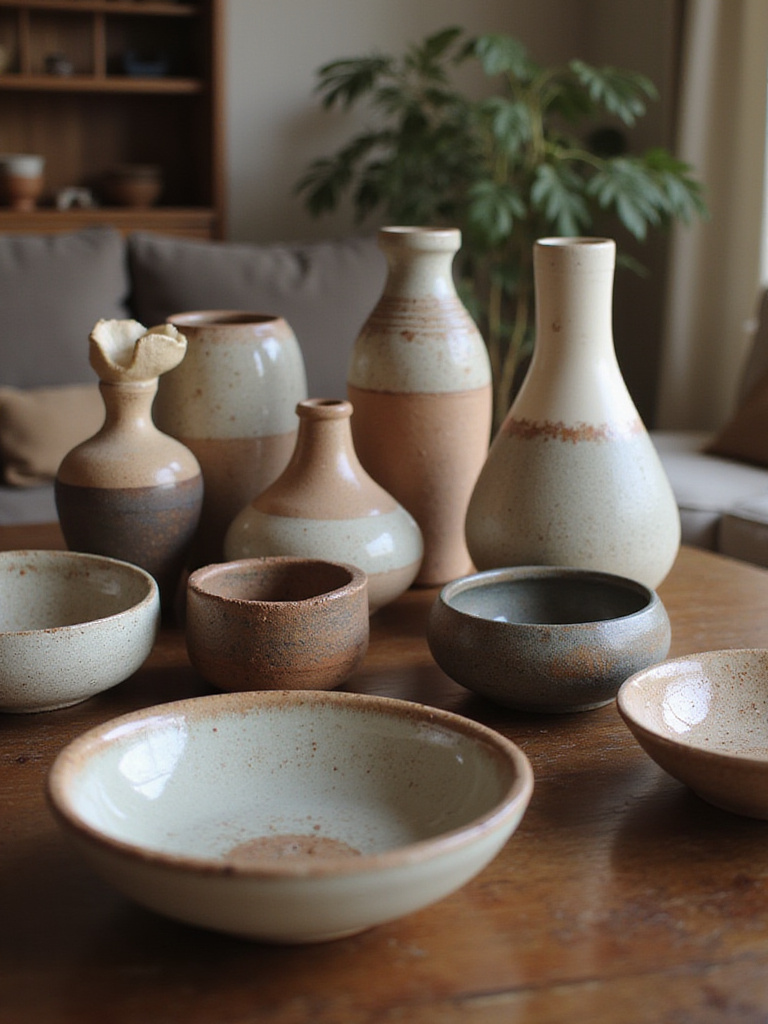
The scale of these conversation areas should feel human and approachable rather than grand or intimidating. Lower seating heights, softer textures, and warm lighting all contribute to creating spaces where people naturally want to settle in and stay awhile. Consider the practical aspects too – side tables for drinks and books, good lighting for evening conversations, and comfortable temperature control that makes extended socializing pleasant.
Multiple conversation areas also provide flexibility for different activities and group sizes. A window seat might be perfect for morning coffee and reading, while a larger seating group accommodates evening gatherings. This variety supports the bohemian lifestyle’s emphasis on spontaneity and organic social interaction.
The emotional response this evokes begins with feeling welcomed and comfortable, encouraging the kind of meaningful connections that make a house feel like a true home.
22. Display Collections with Intention
Collections in bohemian living room decor should feel organic and personal rather than rigid or museum-like. Whether you collect vintage ceramics, interesting stones, or handmade textiles, the key lies in displaying these treasures in ways that honor their individual beauty while creating cohesive visual impact. Group similar items in odd numbers, vary heights and textures, and leave breathing room between pieces to prevent cluttered, overwhelming displays.

The stories behind your collections matter as much as their visual appeal. A group of pottery pieces from different travels creates more interest than a matched set, while the slight variations in handmade items add character that machine-made objects lack. Rotate pieces seasonally or as your collection grows, keeping displays fresh and allowing you to rediscover forgotten treasures.
Consider unconventional display methods that add visual interest while protecting your pieces. Floating shelves, vintage trays, or even repurposed furniture can create unique presentation opportunities that enhance both the objects and your room’s overall aesthetic. The goal is creating displays that feel intentional but not precious, beautiful but still touchable and livable.
- Group by color or theme: Create cohesion through shared characteristics while embracing individual differences
- Vary display heights: Use books, small stands, or risers to create dynamic arrangements
- Rotate regularly: Keep displays fresh by occasionally swapping pieces from storage
Each piece in this collection speaks to a moment in your life, a place you’ve visited, or an artist whose work moved you, creating a personal narrative that unfolds throughout your living space.
23. Integrate Vintage Lighting Fixtures
Lighting fixtures in bohemian spaces should feel like jewelry for your room – beautiful, interesting, and full of character. Vintage pieces bring irreplaceable patina and craftsmanship that new fixtures rarely match, whether it’s a 1960s brass pendant lamp, a collection of vintage table lamps with original shades, or an ornate chandelier that serves as sculptural art when illuminated. These pieces often feature materials and construction techniques no longer common in mass production, adding authentic character to your space.
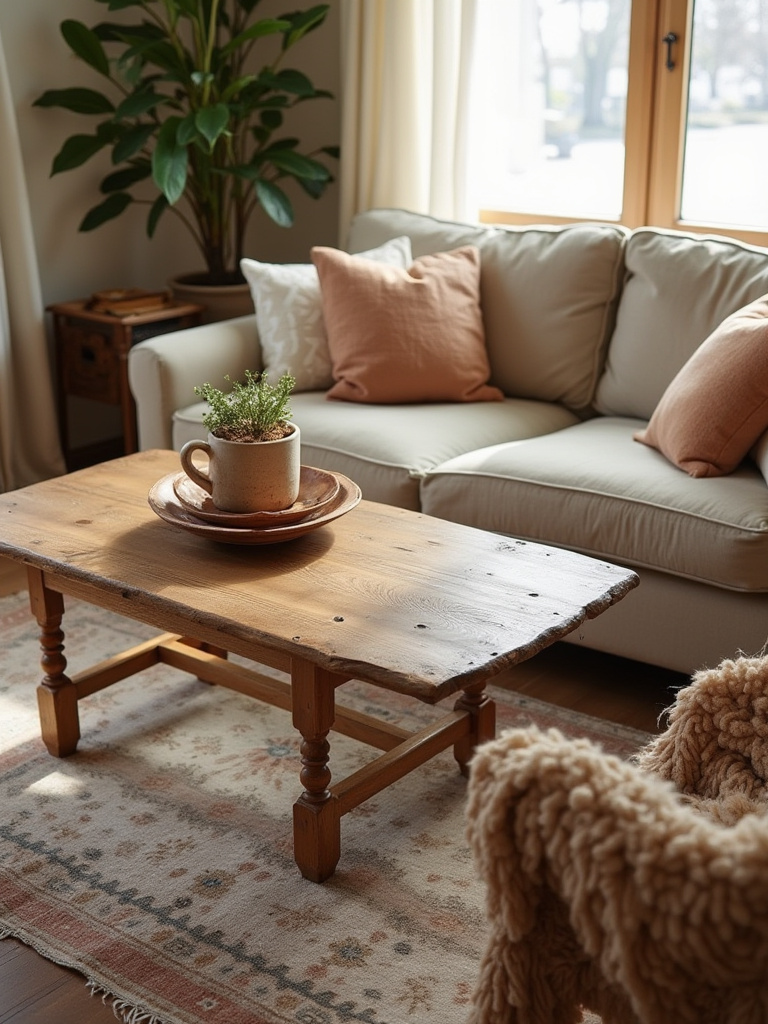
The warm light quality from vintage fixtures often surpasses modern alternatives, particularly when paired with Edison bulbs or other warm-toned options. The aged metal, glass, or fabric components filter light in ways that create ambiance rather than mere illumination. This softer, more romantic light quality enhances the cozy, intimate feeling essential to bohemian living room decor.
Mix different eras and styles while maintaining some unifying elements – perhaps similar metal finishes or complementary color palettes. A mid-century pendant might work beautifully with Victorian table lamps if they share warm brass tones, while the contrast in styles adds visual interest and reflects the eclectic collecting approach central to bohemian aesthetics.
The designer’s attention to detail shows in vintage fixtures through elements like hand-cut glass shades, intricate metalwork, or unique proportions that mass-produced lighting simply cannot replicate.
24. Personalize with Family Heirlooms
The most meaningful elements in bohemian living room decor often come from your own family history – pieces that carry stories, memories, and emotional connections that new purchases simply cannot provide. These heirlooms, whether a grandmother’s quilt, a father’s vintage camera collection, or inherited furniture pieces, add layers of personal narrative that make your space uniquely yours. The gentle wear and patina on these pieces tells stories of previous lives and loving use.
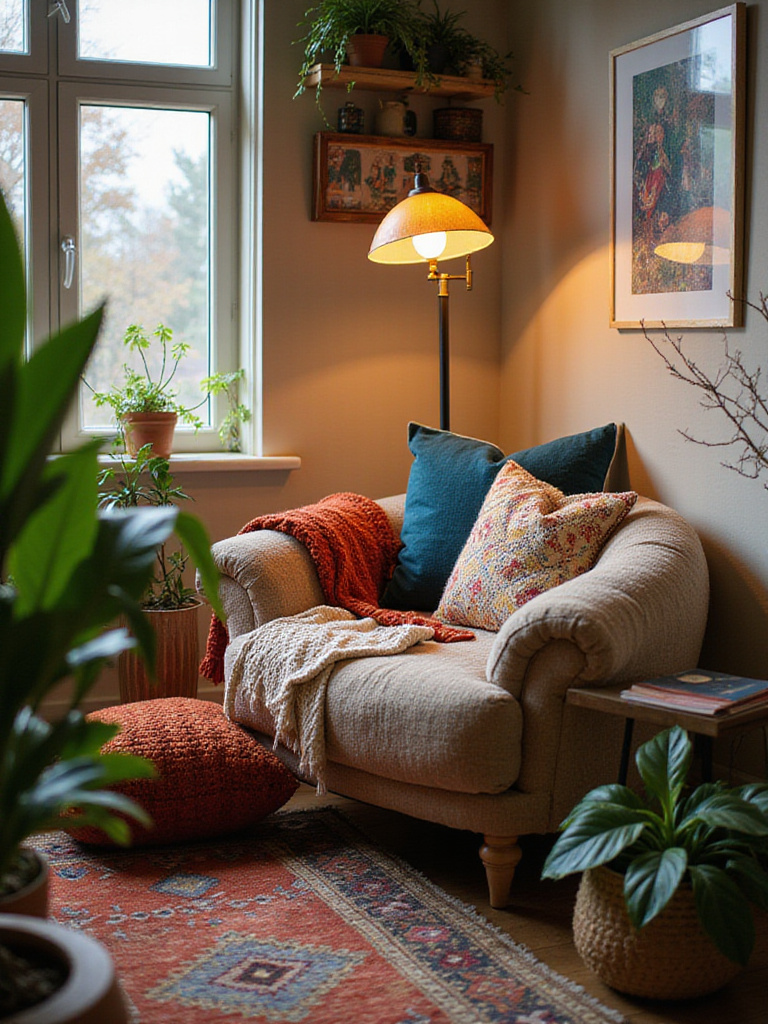
Integrating family pieces requires balancing respect for their history with your current aesthetic needs. Sometimes this means gentle restoration – reupholstering a cherished chair in fabric that honors both its original character and your current style, or displaying vintage photographs in new frames that complement your decor while preserving their historical significance. The goal is creating harmony between past and present rather than sacrificing either.
These personal elements often become conversation starters and focal points, connecting your space to larger family narratives and cultural traditions. A vintage trunk that served as your great-grandmother’s hope chest might now function as a coffee table, carrying its history into your contemporary life while serving practical needs.
The cultural heritage preserved in each piece includes not just its physical form but the memories, traditions, and stories that give your bohemian living room its deepest meaning and most authentic character.
Conclusion
Creating an authentic bohemian living room isn’t about following a rigid checklist or achieving a magazine-perfect look – it’s about cultivating a space that breathes with your personal story and evolves with your life’s journey. These 24 ideas serve as inspiration rather than rules, encouraging you to trust your instincts and embrace the beautiful imperfections that make a space truly yours. The magic happens when vintage textiles meet contemporary comfort, when global treasures blend with family heirlooms, and when every corner reflects your unique perspective on beauty and living.
Remember that the most compelling bohemian living room decor develops organically over time, growing richer and more personal with each thoughtful addition. Start with elements that speak to your heart – perhaps a single vintage rug that captures your imagination or a collection of plants that brings life to your space. Allow your room to evolve naturally, adding pieces as you discover them rather than rushing to complete a predetermined vision.
Your bohemian living room should ultimately serve as a sanctuary that nurtures your spirit and welcomes others with warmth and authenticity. Embrace the journey of creating this space, celebrating each discovery and allowing your room to tell the ongoing story of who you are and how you choose to live. The most beautiful bohemian spaces aren’t perfect – they’re perfectly personal, reflecting the rich tapestry of experiences, relationships, and dreams that make life meaningful.
